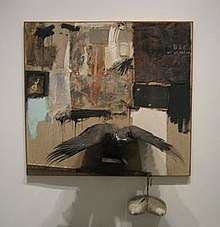Canyon (Rauschenberg)
Canyon is a 1959 artwork by American artist Robert Rauschenberg.[1][2] The piece is one of his most celebrated and best known works,[3] and is one of his combine paintings, which incorporated elements of sculpture into canvas-based pieces. Canyon features a taxidermied eagle, a pillow, and other elements.
| Canyon | |
|---|---|
 | |
| Artist | Robert Rauschenberg |
| Year | 1959 |
| Type | Oil, pencil, paper, metal, photograph, fabric, wood, canvas, buttons, mirror, taxidermied eagle, cardboard, pillow, paint tube and other materials |
| Location | MOMA, New York City |
Canyon was subject to an ownership controversy after the death of its owner, Ileana Sonnabend, which ultimately resulted in its donation to MoMA.
Materials
Between 1954 and 1965, Rauschenberg created "combine paintings" which involved affixing sculptural elements to more typical canvases. Elements such as photographic images, clothing and newspaper clippings could be attached either by paint, with string, or by other means. Other examples of such paintings are Reservoir and Monogram.
Canyon features a taxidermied golden eagle, a pillow attached with string, a paint tube, and various textiles. The eagle was given to Rauschenberg by Sari Dienes, and formerly belonged to a Rough Rider.[4][5]
Ownership history
The painting was originally owned by Ileana Sonnabend, an art dealer, until her death. She was a friend of Rauschenberg, and considered the piece to be one of her favorites.[6] Sonnabend's heirs were forced to donate the piece after the IRS established the piece's value at $65 million and charged the Sonnabends $29 million in taxes. However, due to the golden eagle attached to the canvas, sale of the painting is a felony; as such, the estate's appraisers had placed a value of $0 on the painting, so forcing the heirs to donate.[7]
Before its donation to MoMA, the piece was displayed on and off at The Metropolitan Museum of Art, due to an earlier conflict between Sonnabend and the United States Fish and Wildlife Service over the piece, which forced Sonnabend to allow Canyon to be displayed publicly in order to keep it in her possession. Although MoMA ultimately won out, the Met also attempted to persuade Sonnabend's family to donate the piece to their institution.
Canyon has been part of MoMA's permanent collection since 2012. After the work was accessioned, a show celebrating both it and Sonnabend titled Ileana Sonnabend: Ambassador for the New was held at MoMA.[8]
In popular culture
The painting is featured in Eugene Lim's 2017 novel Dear Cyborgs.
References
- Folland, Tom. "Robert Rauschenberg, Canyon". Khan Academy. Retrieved 14 March 2016.
- "Canyon". MOMA. 21 December 2013. Retrieved 14 March 2016.
- "Exhibition Overview". The Metropolitan Museum of Art. 20 December 2005. Retrieved 14 March 2016.
- Kim, Hannah (24 January 2014). "Diving into Rauschenberg's Canyon". MoMA. Retrieved 14 March 2016.
- Gibson, Eric (2 December 2012). "The Illegal Eagle and a Baldly Grasping IRS". The Wall Street Journal. Retrieved 14 March 2016.
- Cohen, Patricia (28 November 2012). "MoMA Gains Treasure That Met Also Coveted". The New York Times. Retrieved 14 March 2016.
- Brooks, Katherine (28 November 2012). "Robert Rauschenberg's 'Canyon' Donated To MoMA (PHOTO)". Huffington Post. Retrieved 14 March 2016.
- Cotter, Holland (19 December 2013). "A Legendary Dealer's Eagle Eye". The New York Times. Retrieved 14 March 2016.